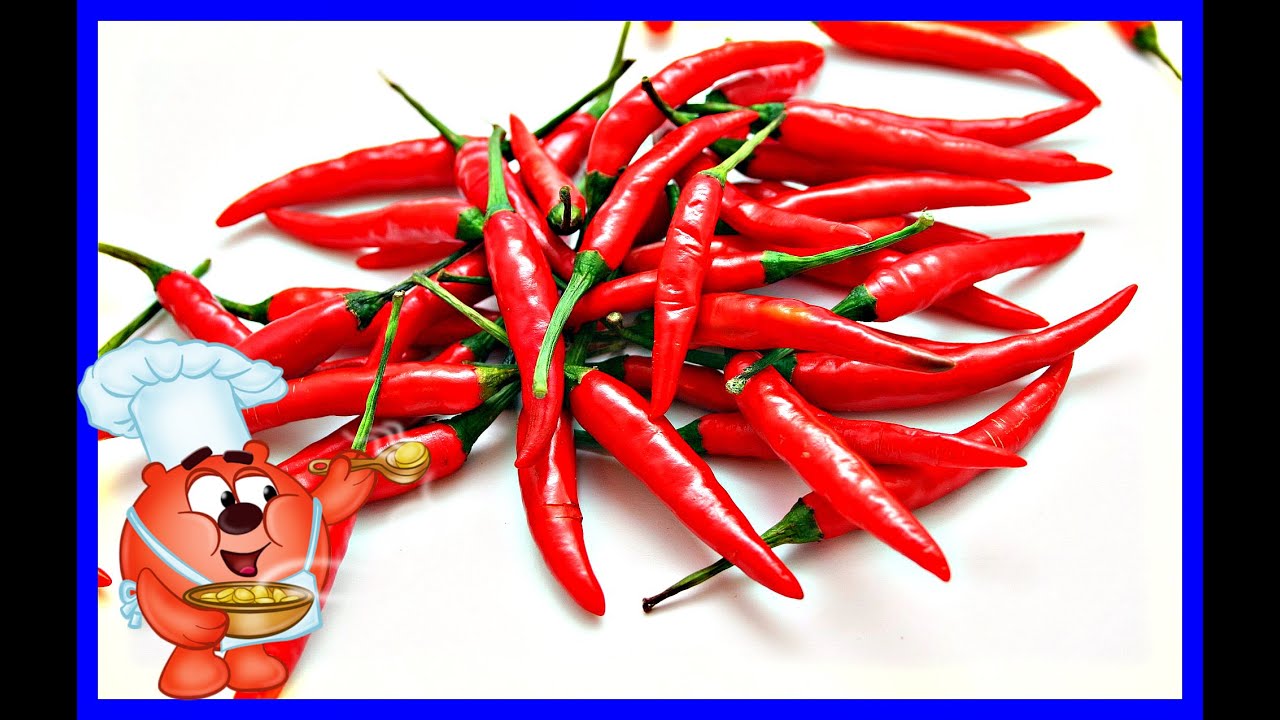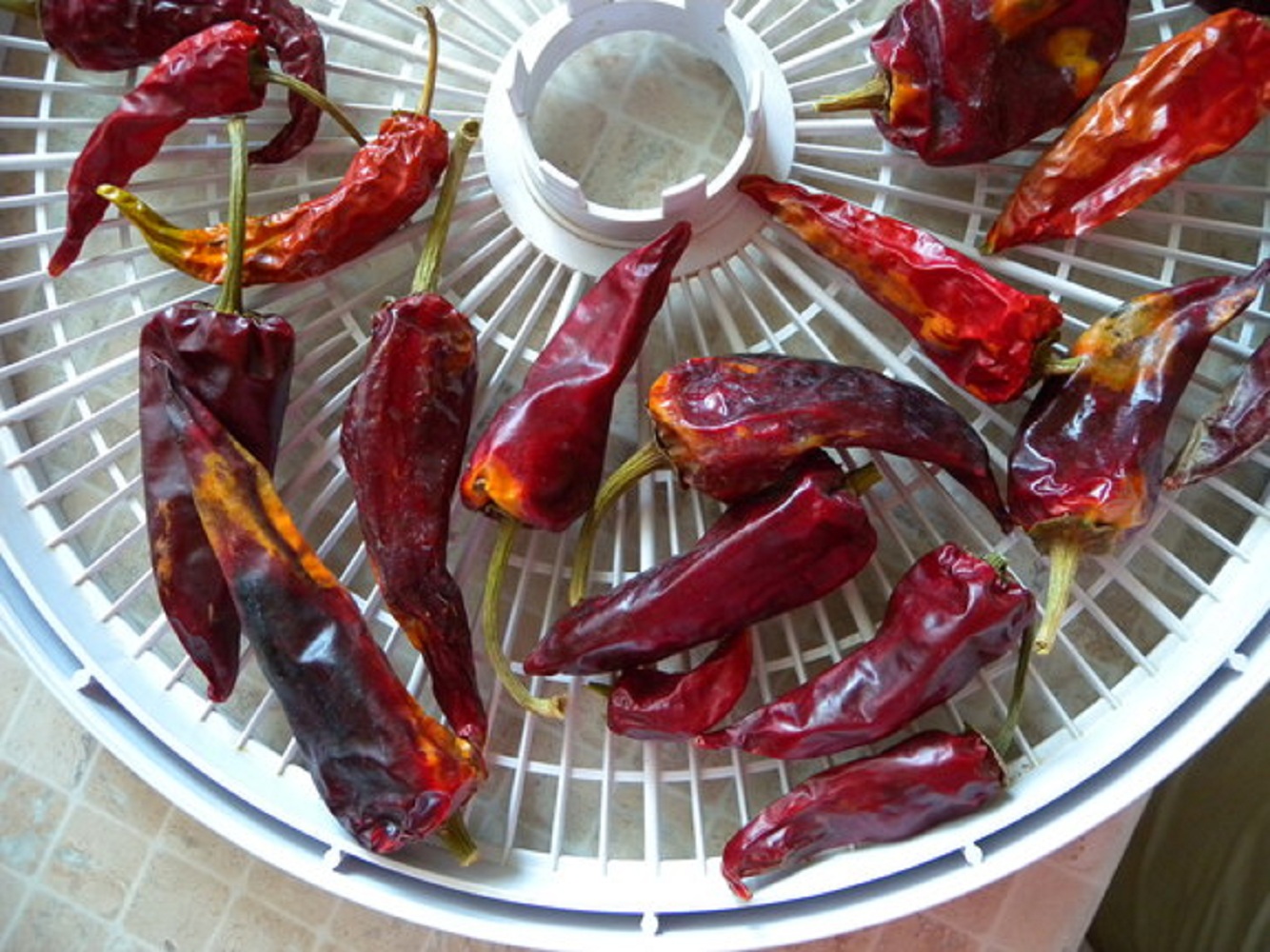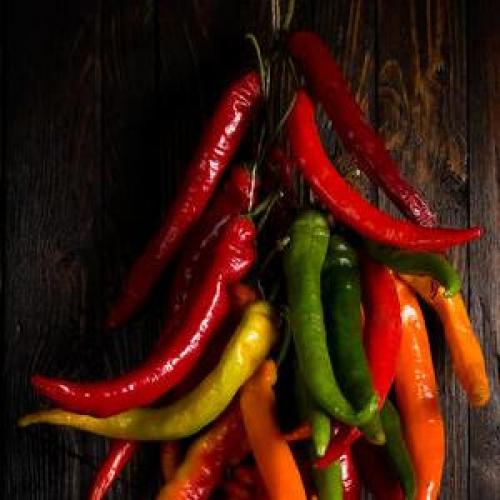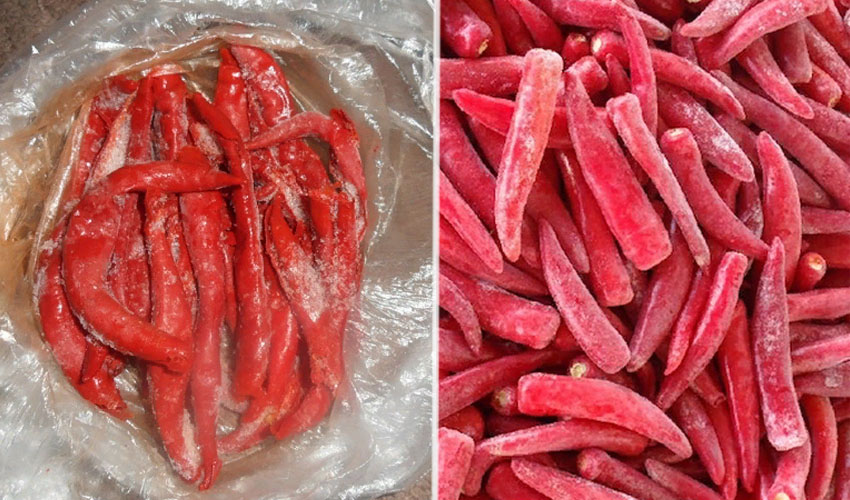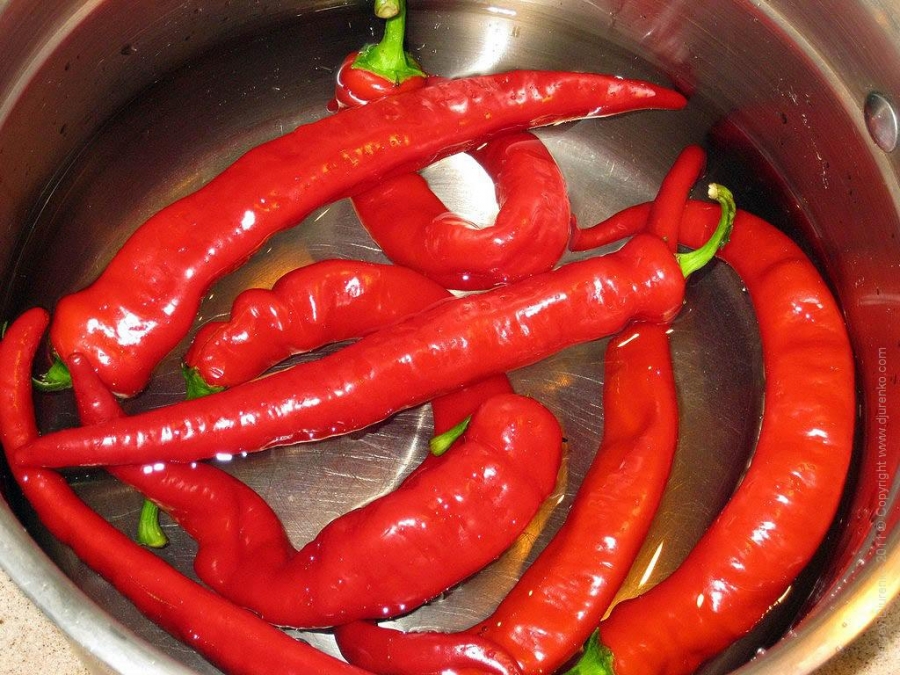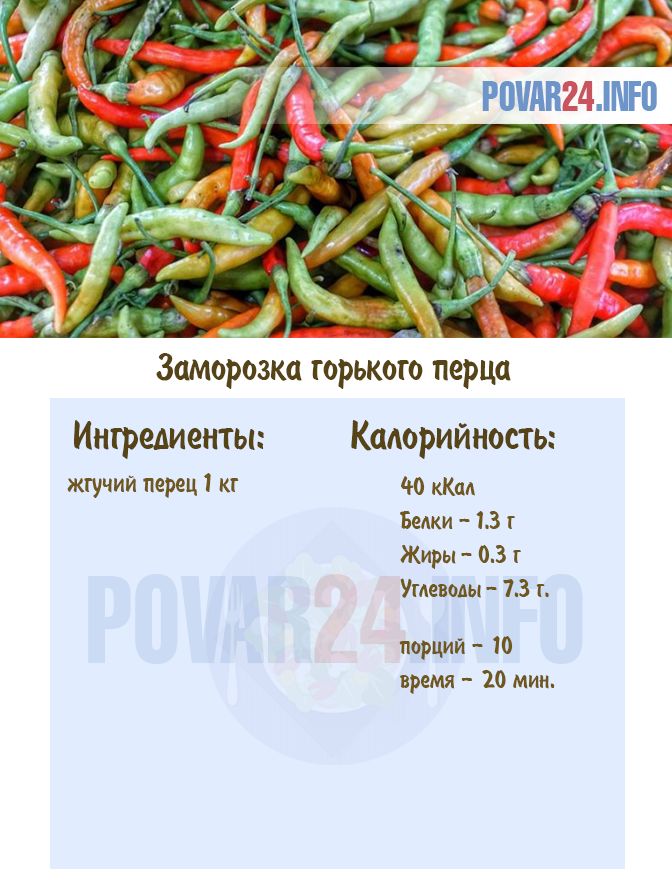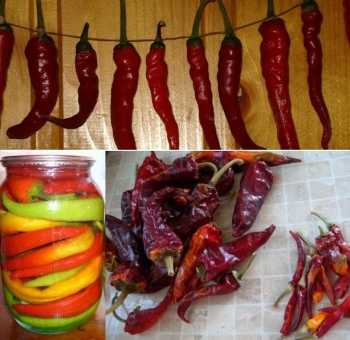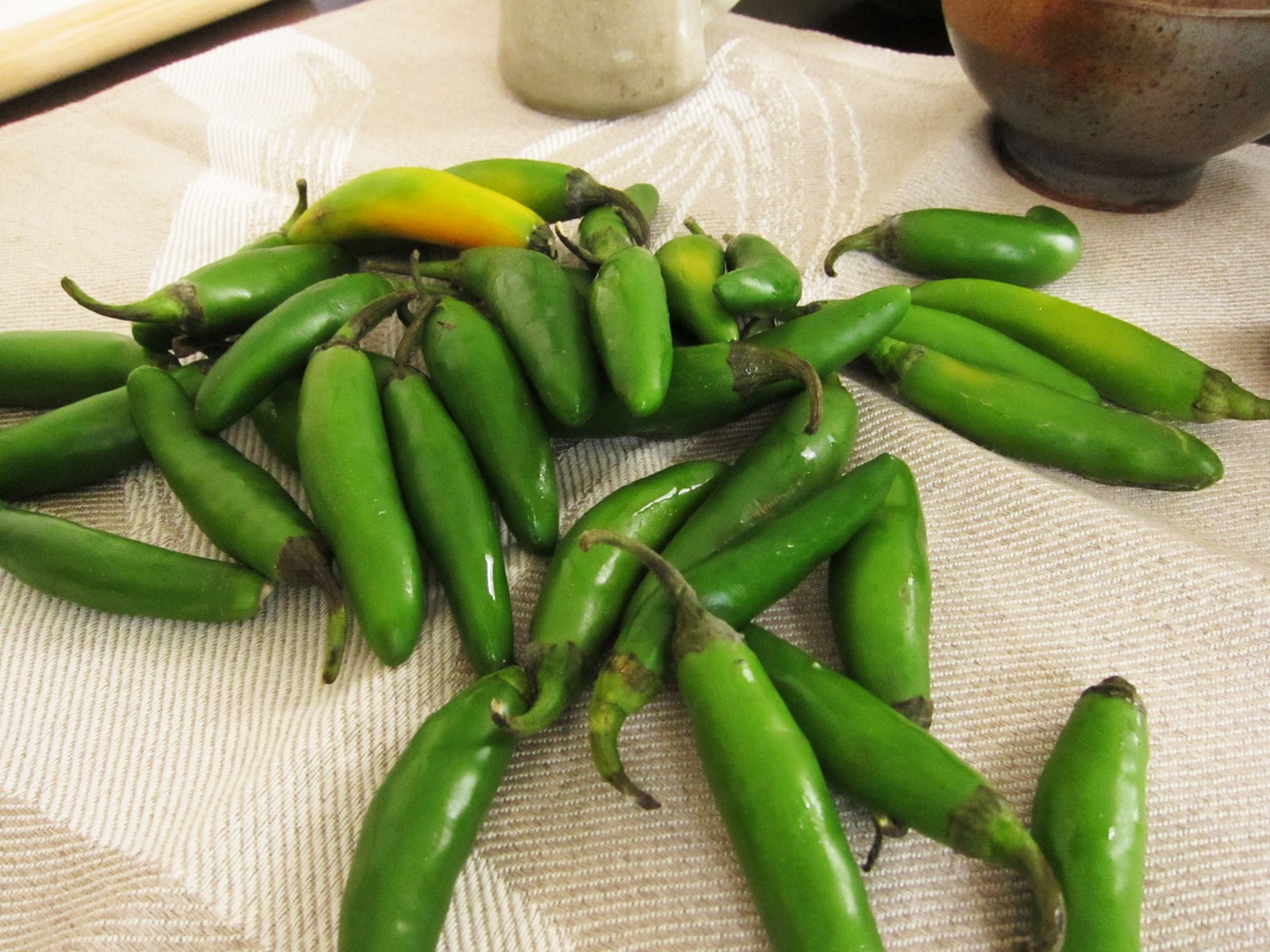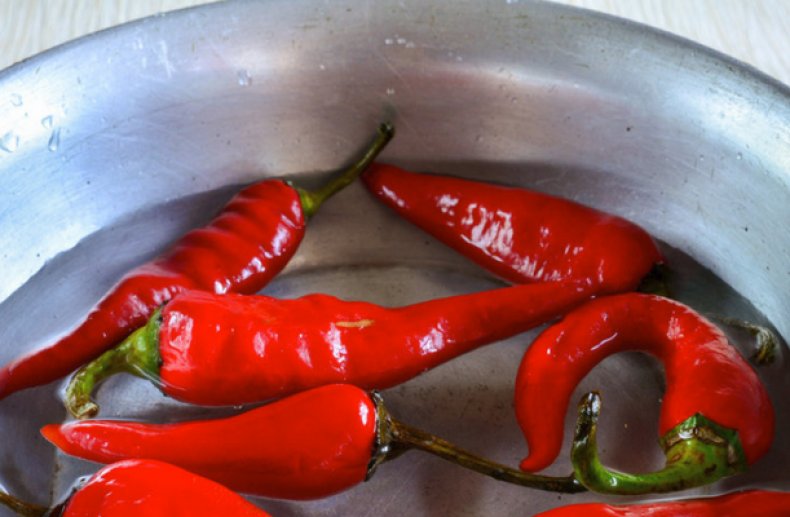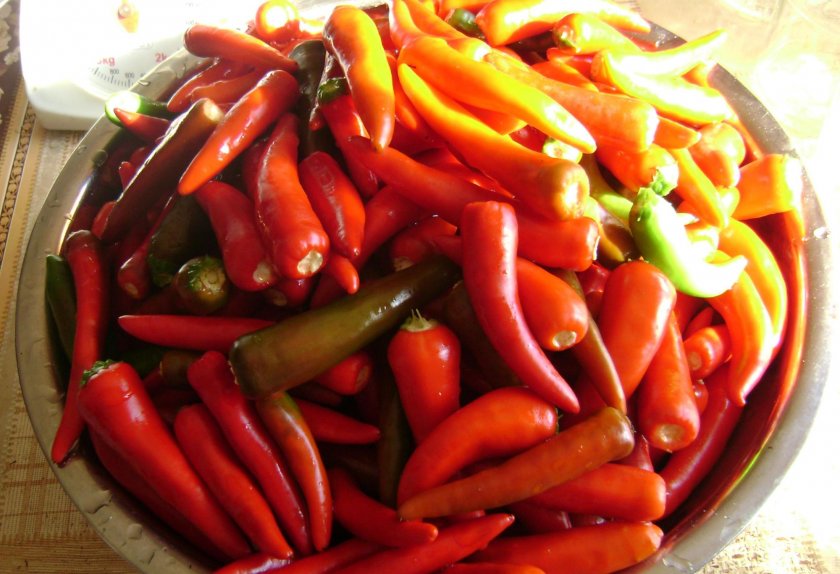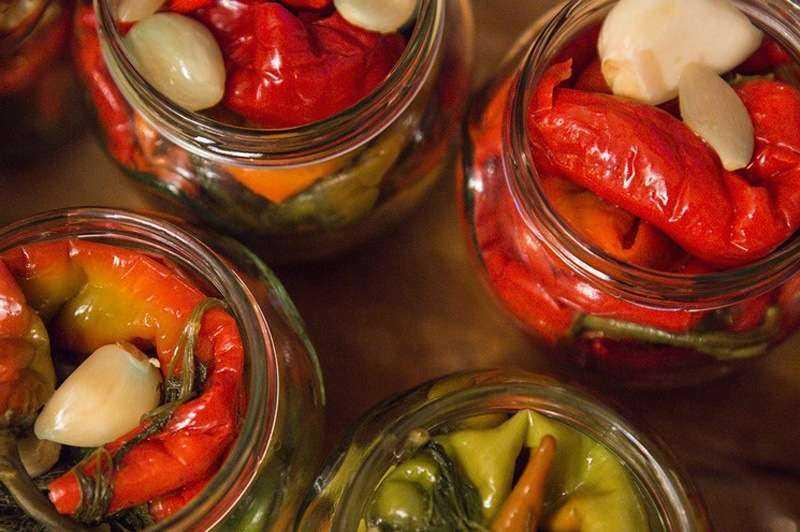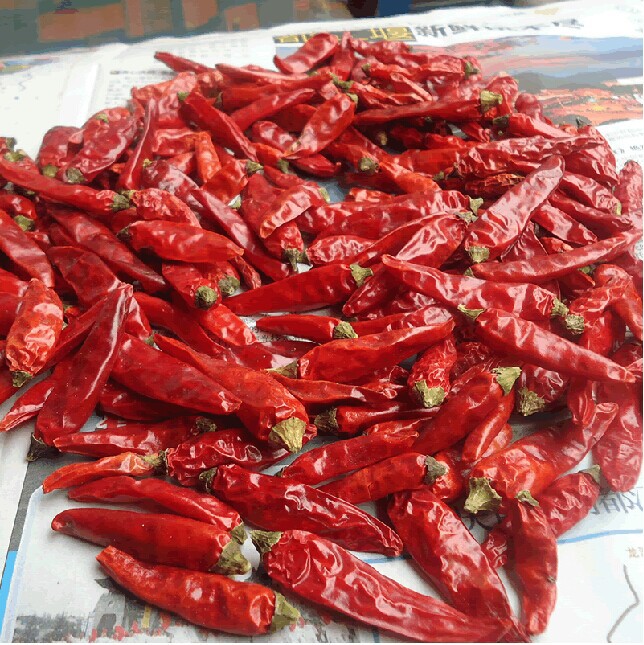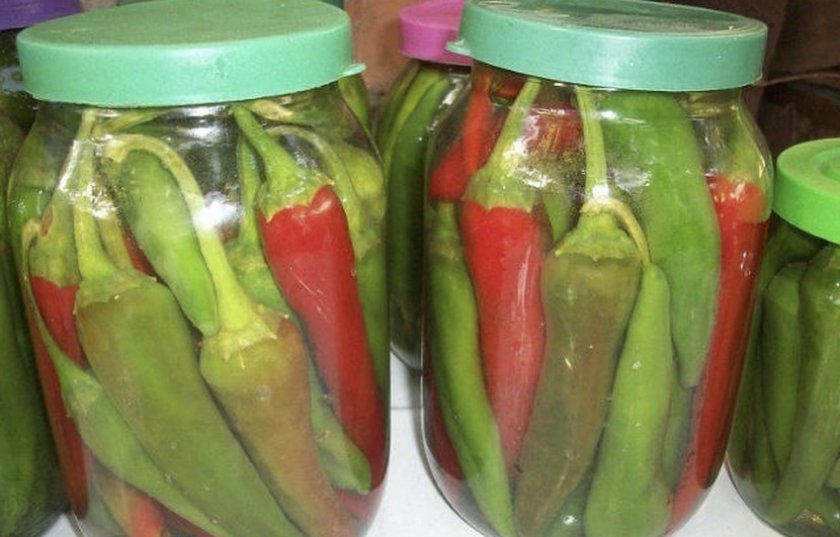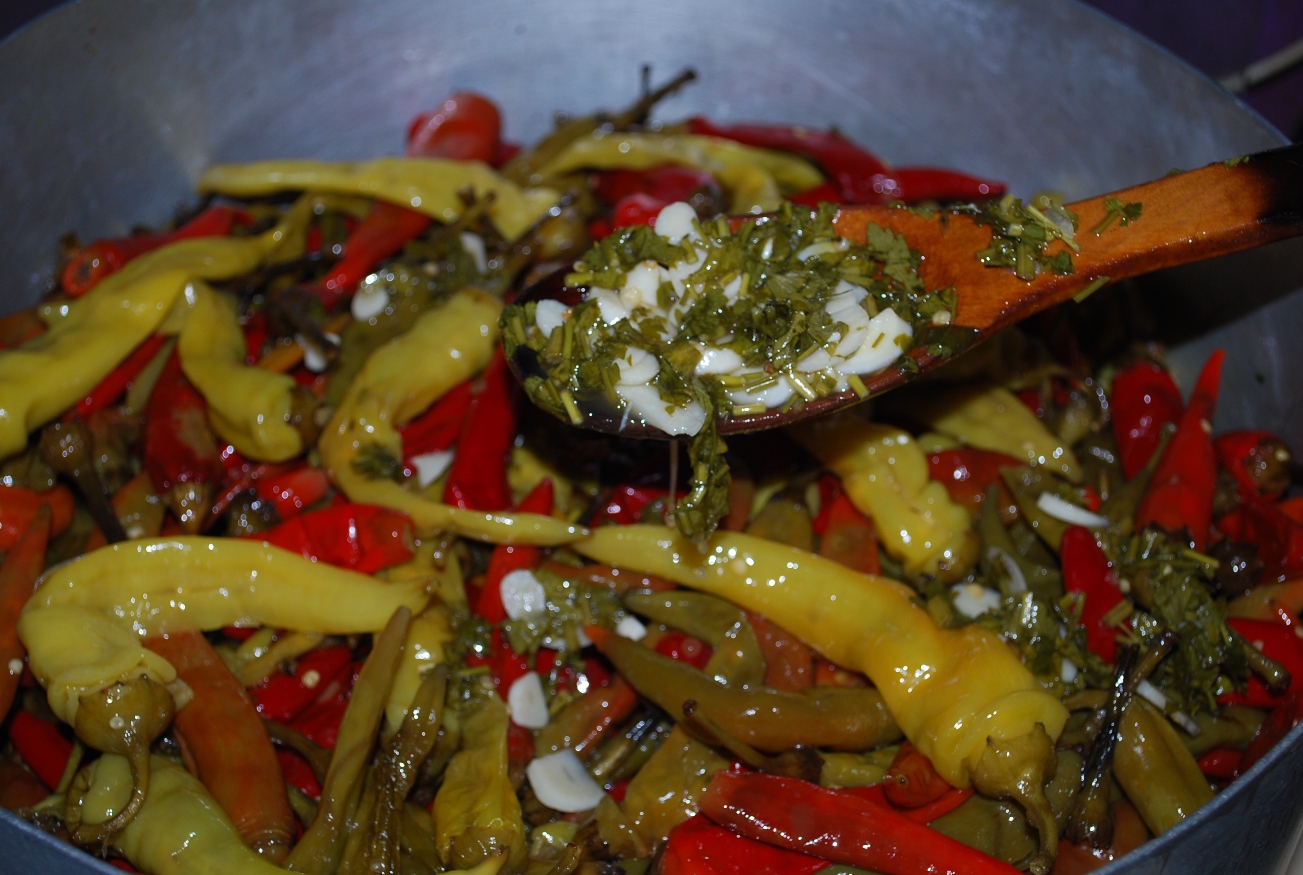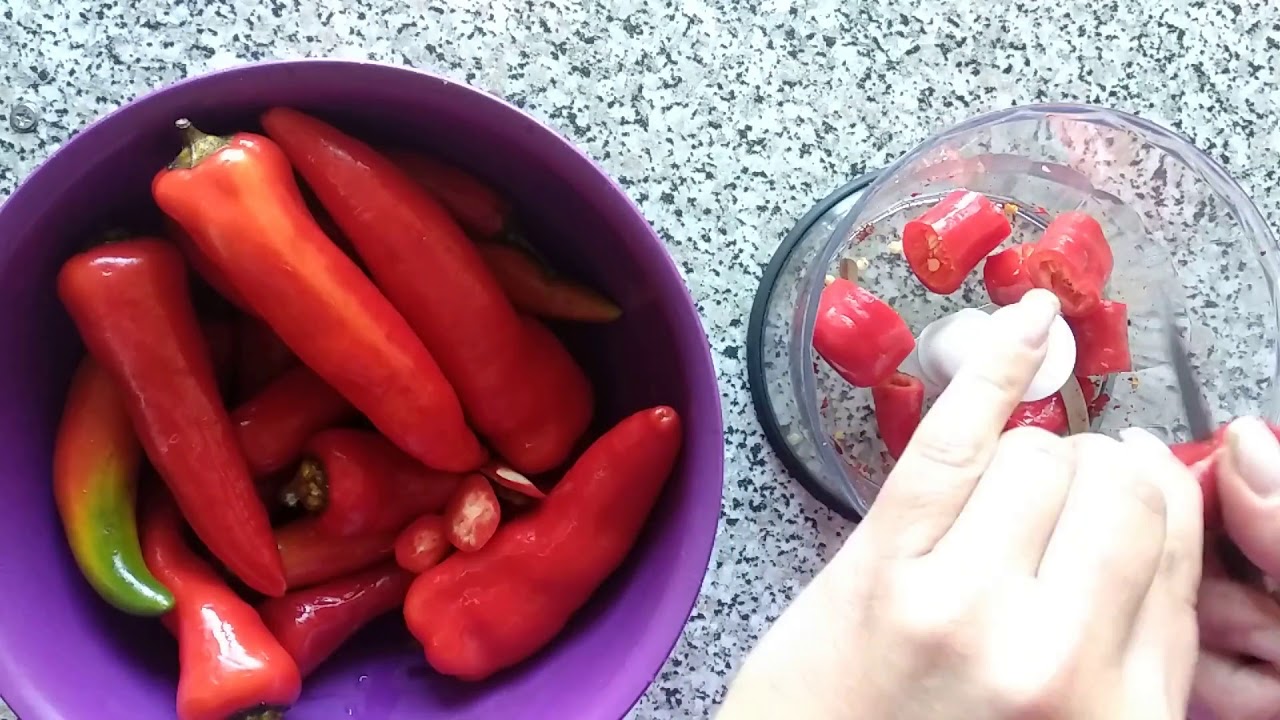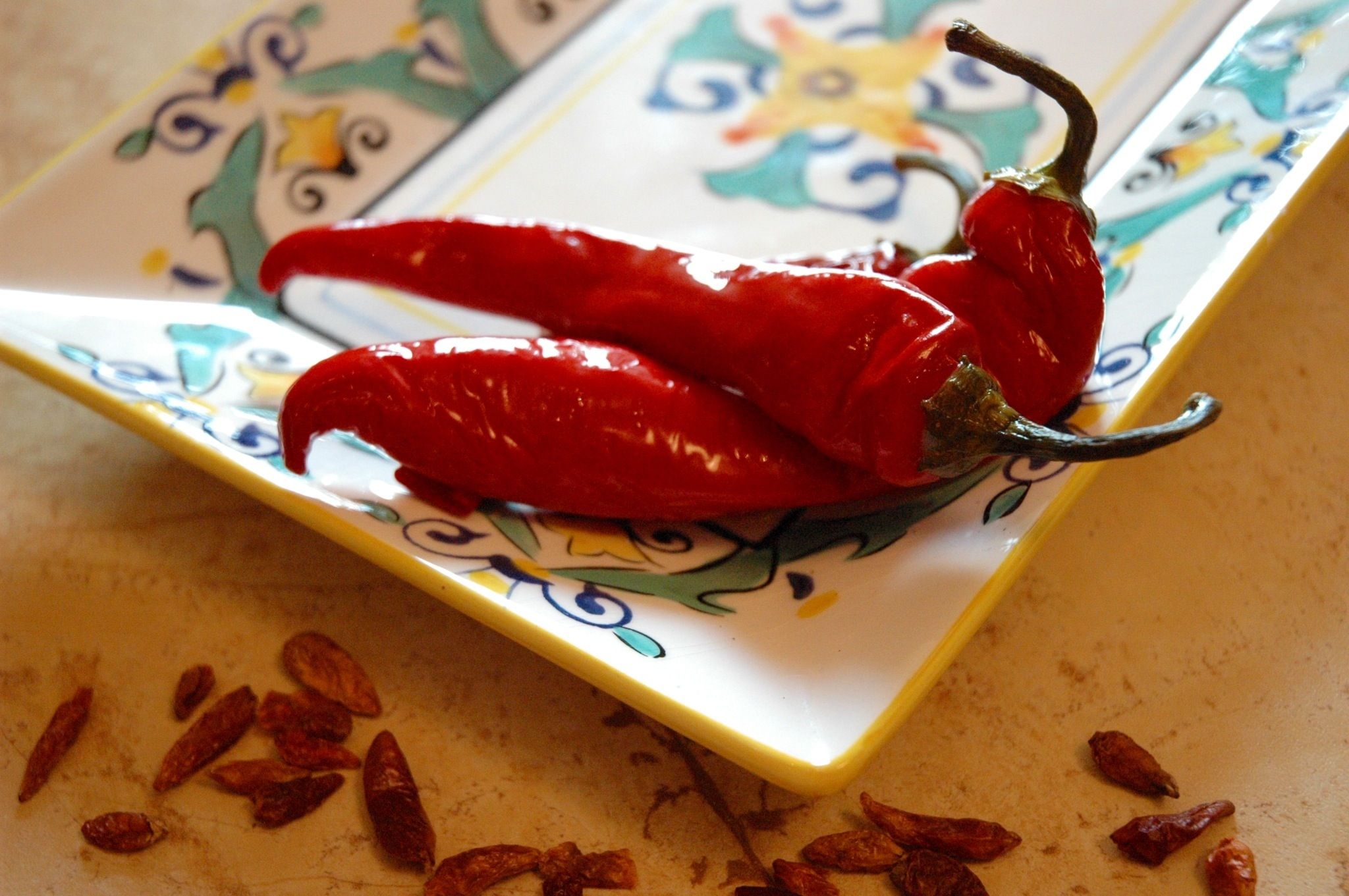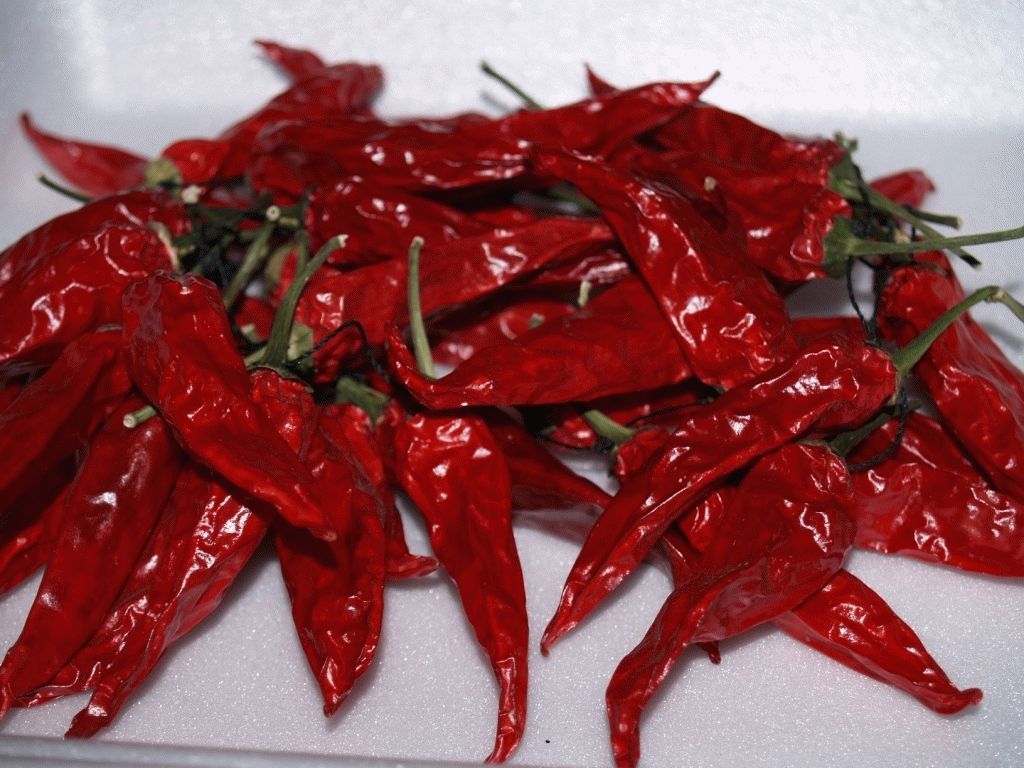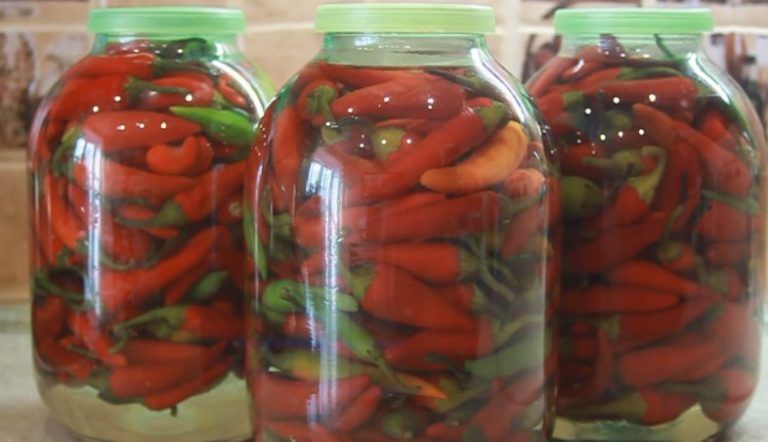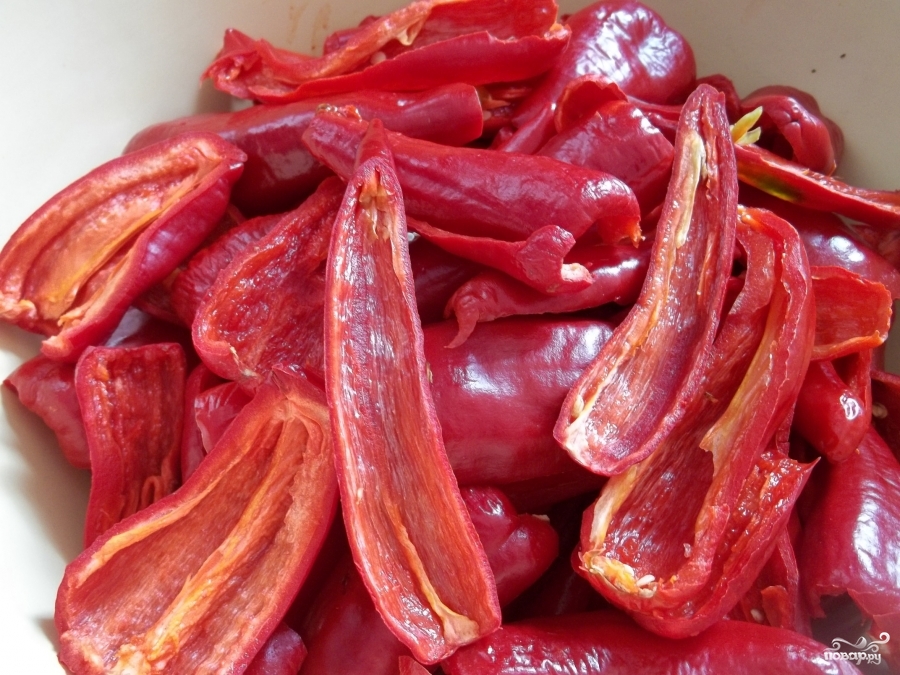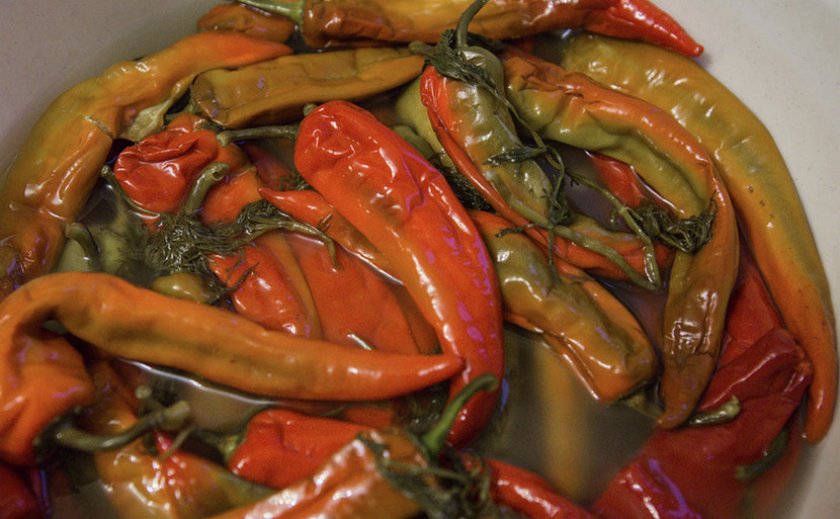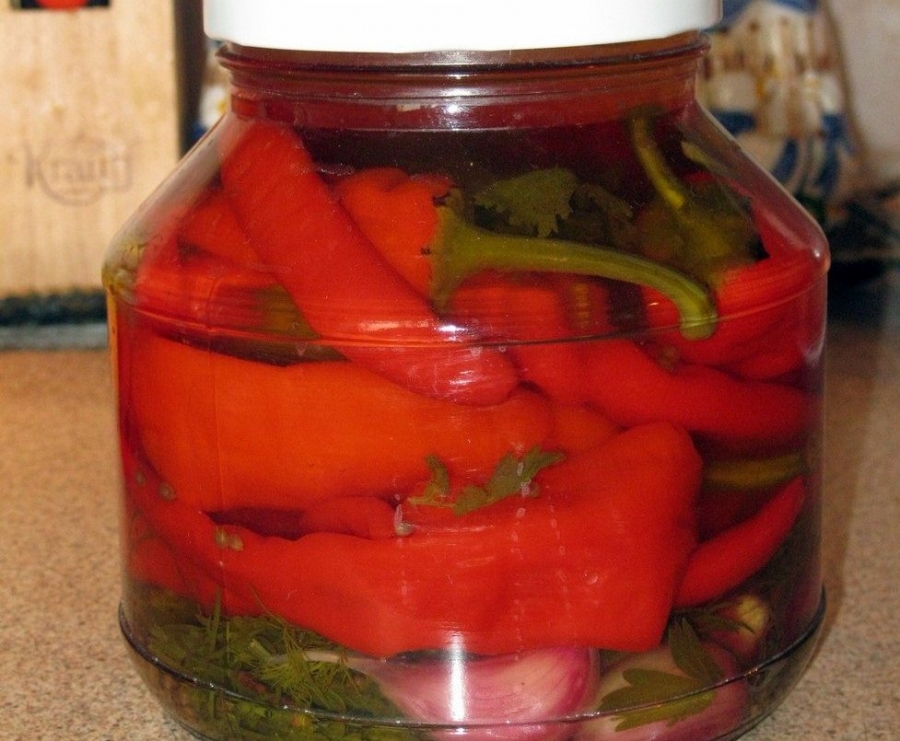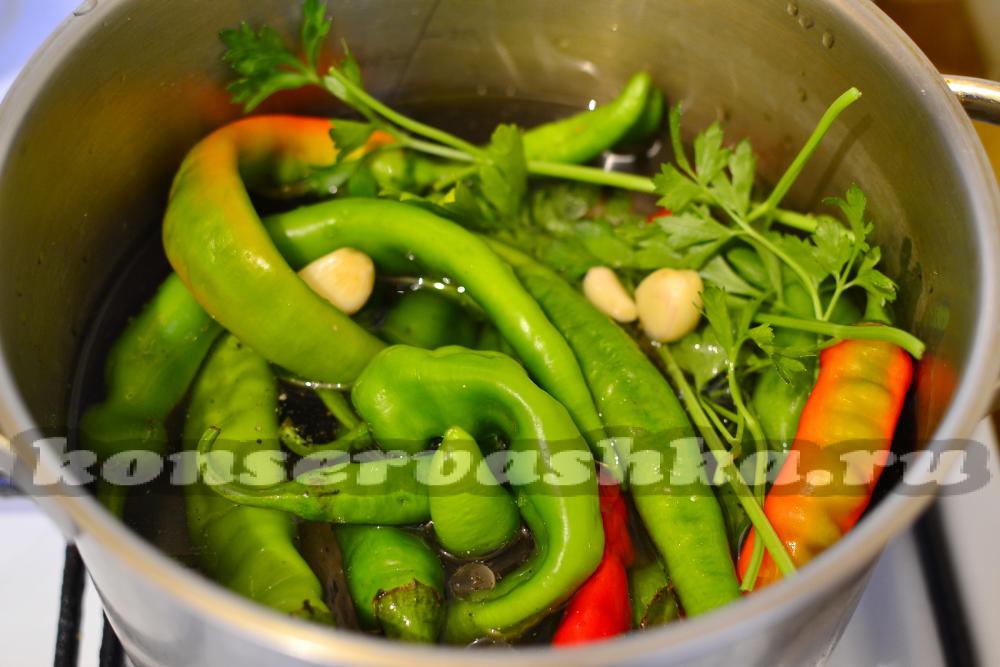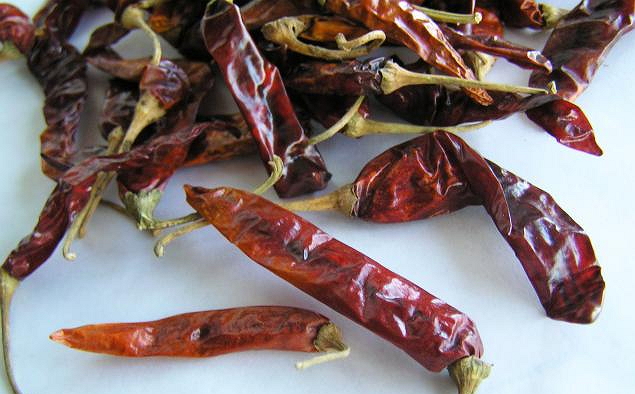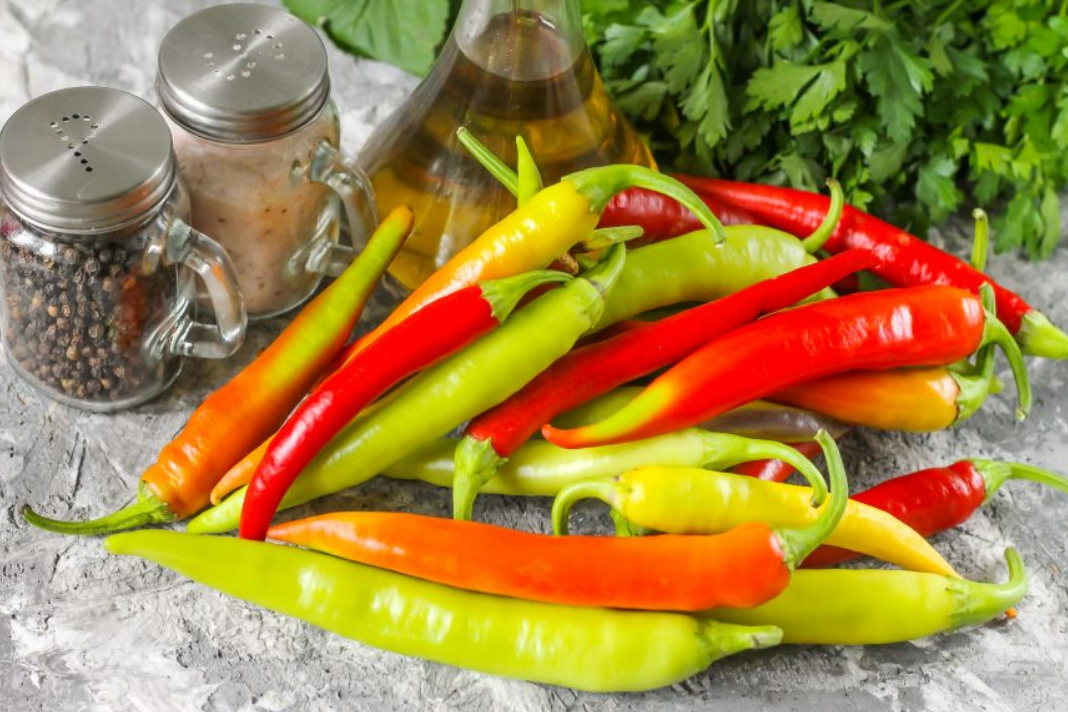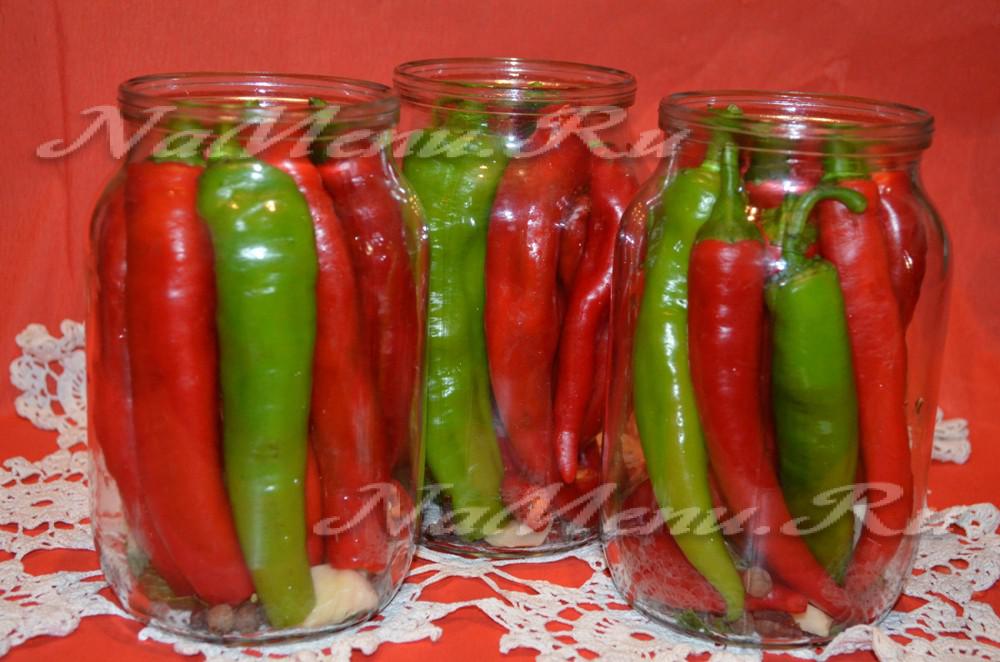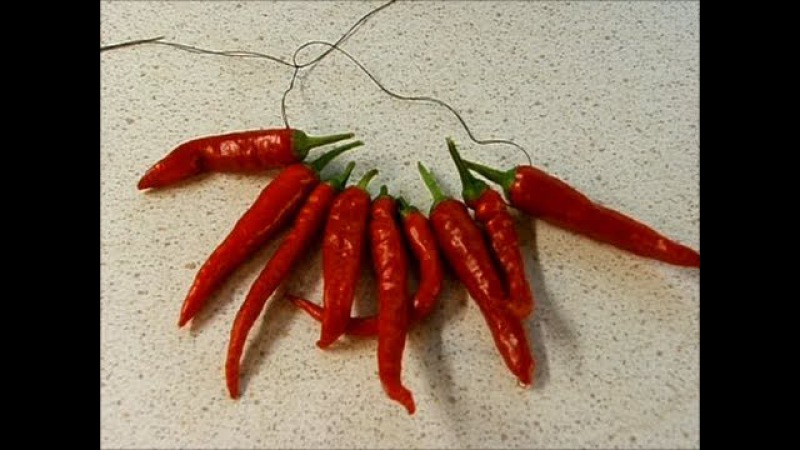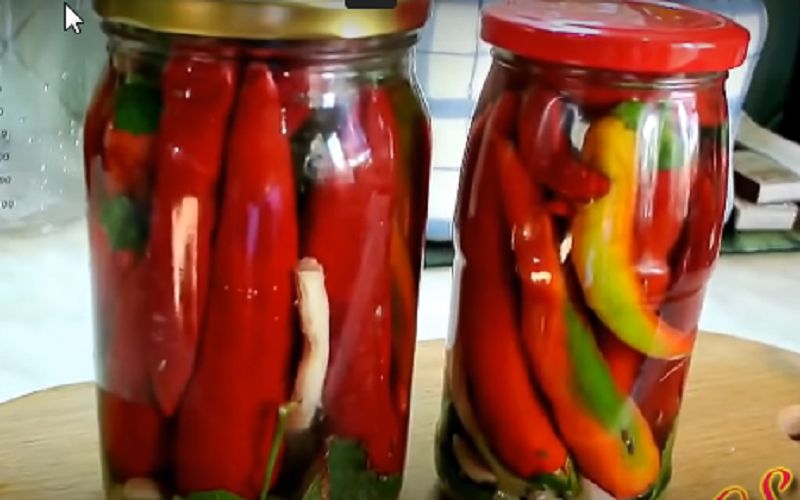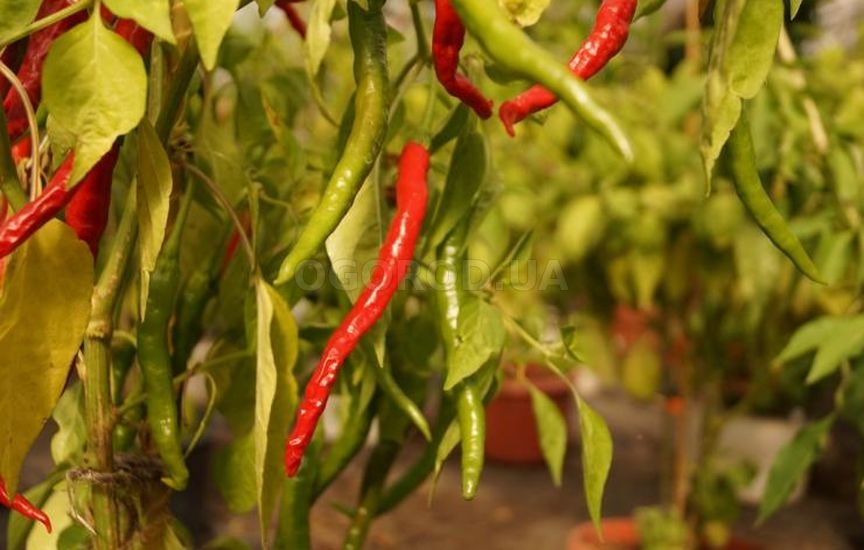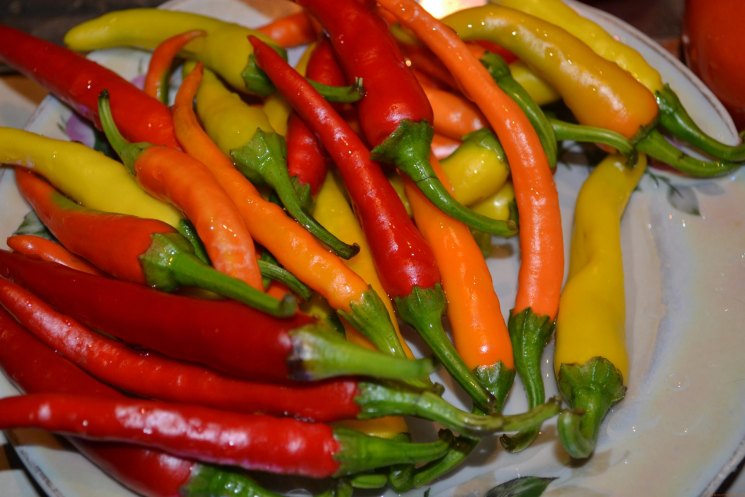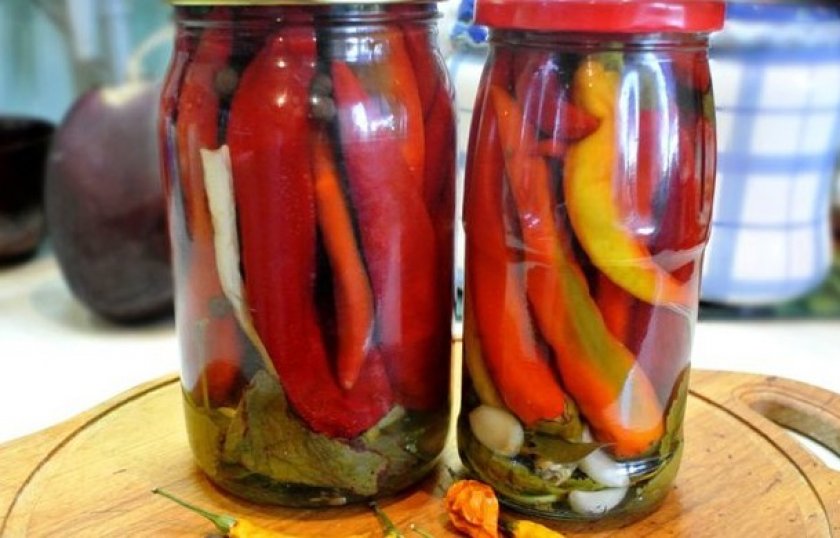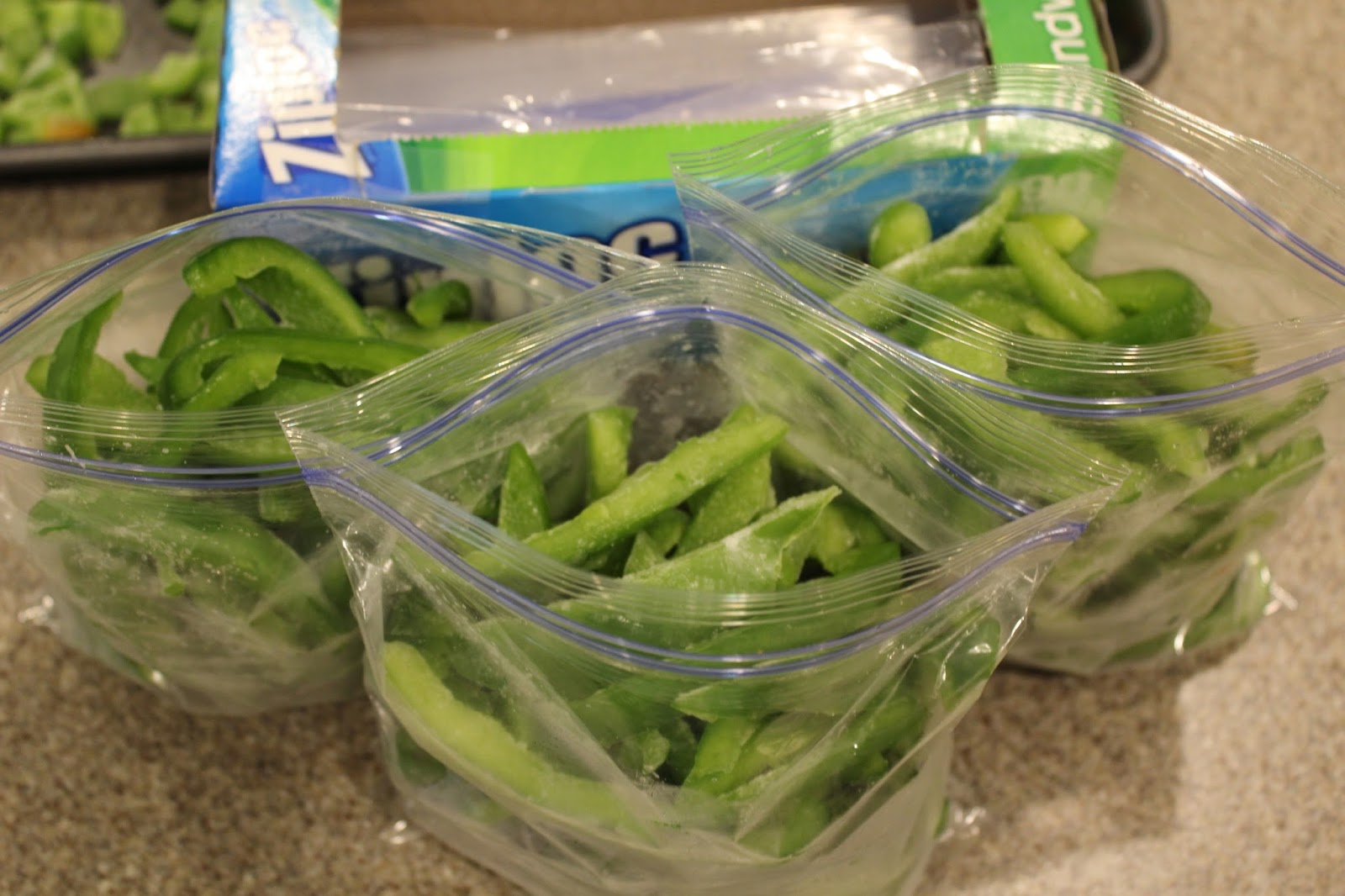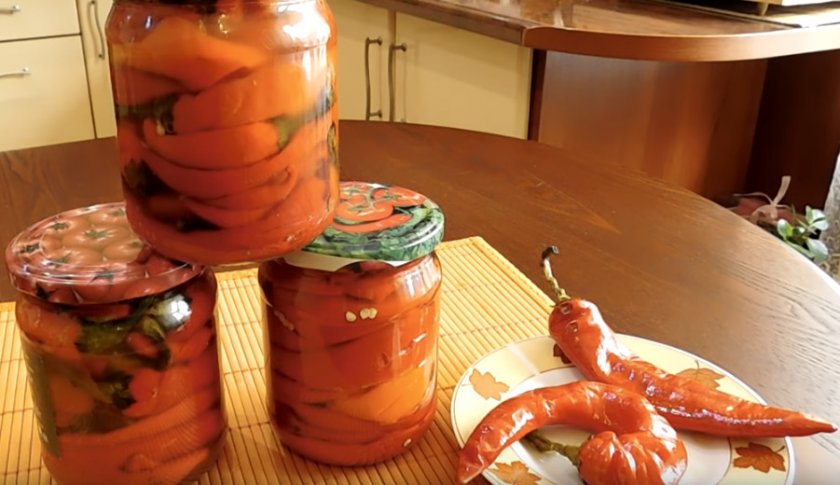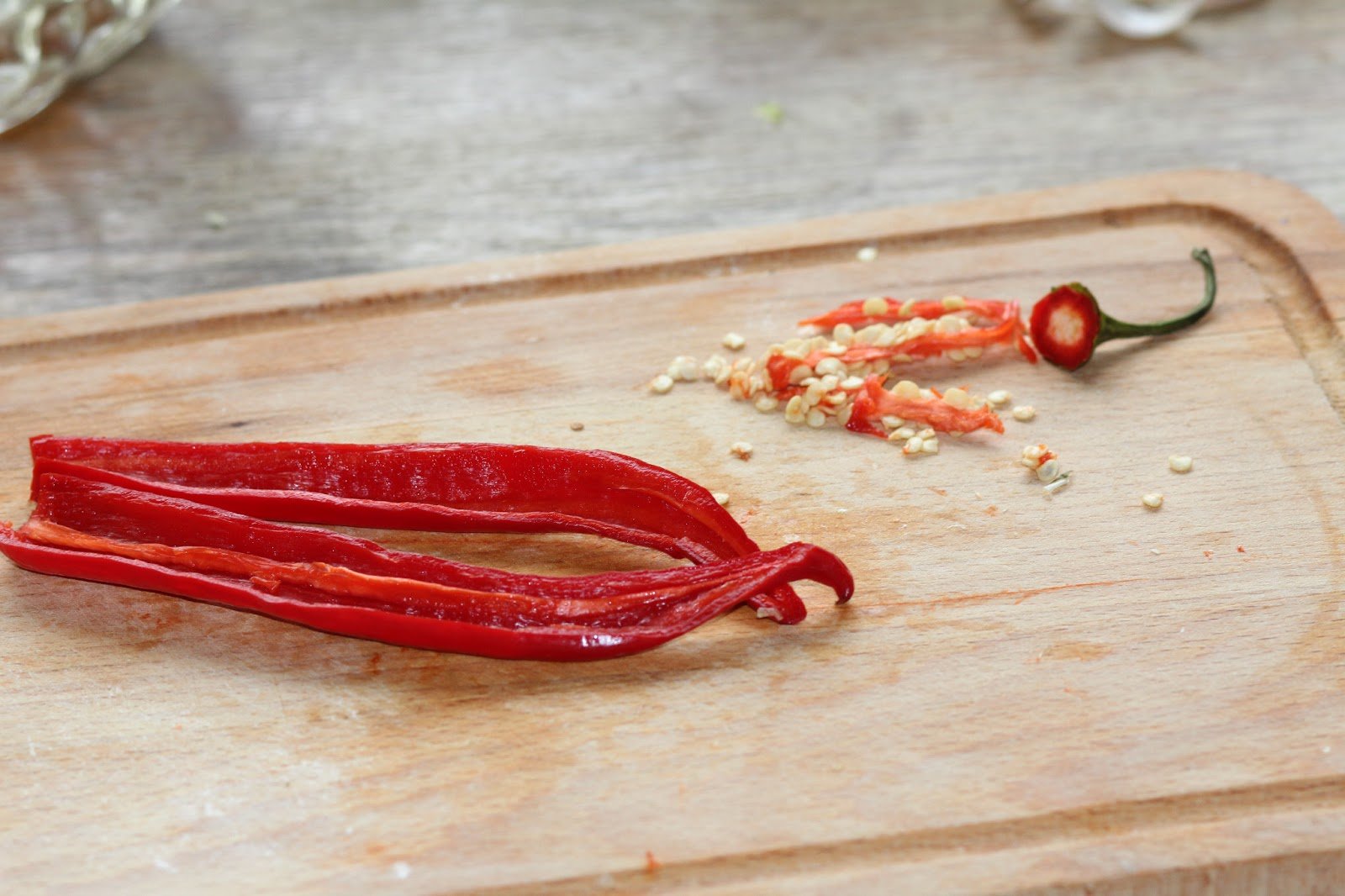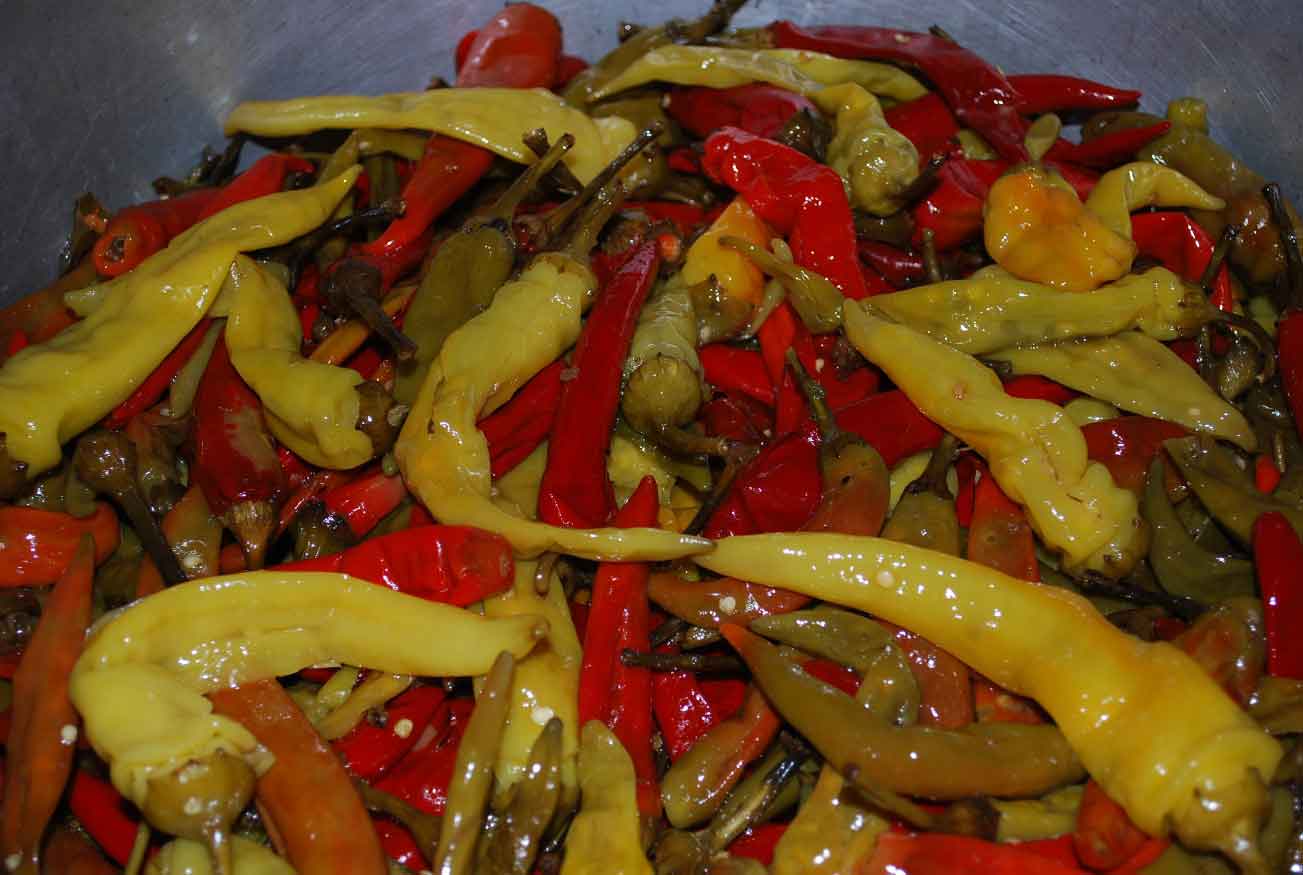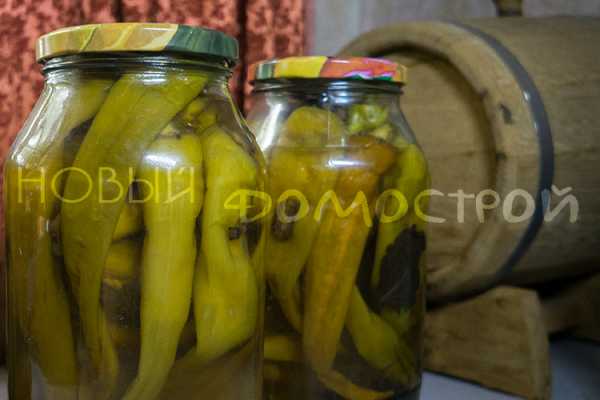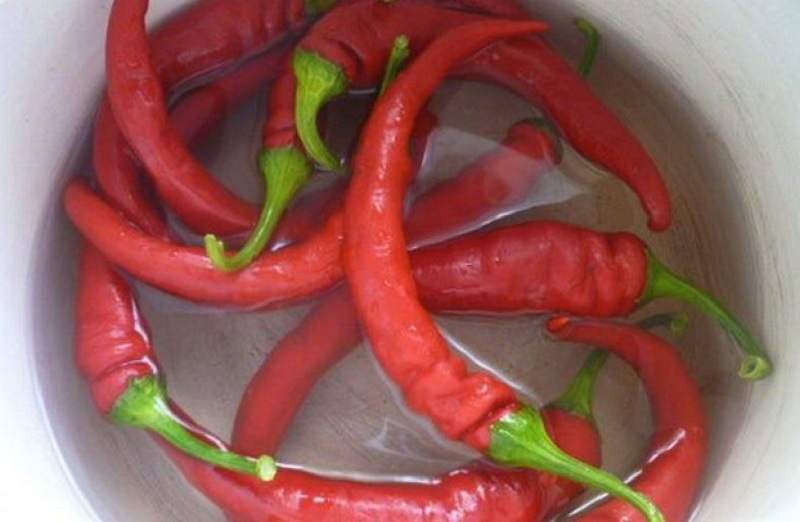Dry
Dried peppers do not lose their pungency and pungency. Dried fruits can be stored for up to several years.
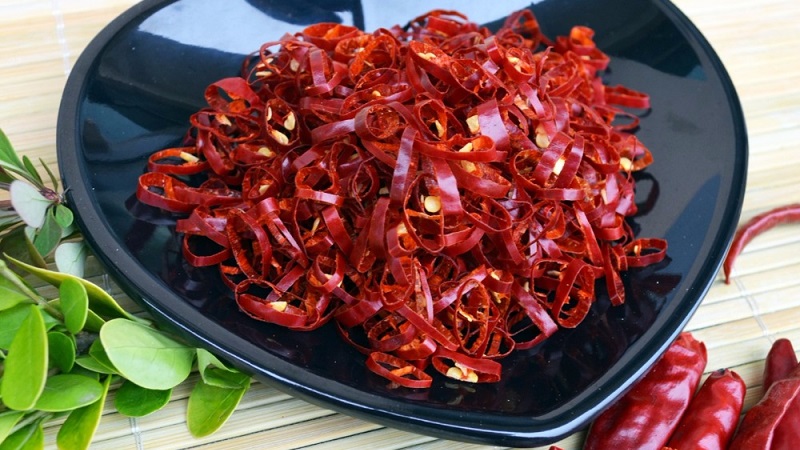
On air
You can air dry hot peppers in pieces or whole. Often, housewives prefer to dry peppers without violating the integrity of the fruit. Peppers are collected in bunches, tied with twine or threads by the stalk and hung to dry in a dry, cool, ventilated place.
It takes about 1-2 weeks to dry. Bundles-bundles are subsequently used not only for culinary purposes, but also as an interior decoration for a kitchen or home.
In the oven
Hot peppers dry faster in the oven than in the air. The whole process takes 2.5 to 5 hours.
To dry the peppers, heat the oven to 40-50 ° C. A baking sheet is covered with parchment paper and clean fruits (whole or cut) are spread on top. They are turned over every 30 minutes to dry evenly.
In an electric dryer
In an electric dryer, the pepper will dry faster than in the oven. Depending on the drying power and the thickness of the fruit walls, the product ready for storage can be obtained within 1-2 hours.
The whole peppercorns or in pieces are laid out on the drying tiers, then the device is connected to the power grid. The tiers are swapped every 15 minutes. Dry pods are placed in a glass jar.
One of the most common ways to store dried peppers is to grind it into powder (twist it into a meat grinder), put the ground mass in a sterile glass jar and put it in a dry place (optionally in the refrigerator).

The benefits of hot peppers
Everyone knows about the pungency of this vegetable, but not everyone knows about its beneficial properties. The pods get their hot taste thanks to the alkaloid capsaicin they contain. In addition to making dishes spicy, capsaicin is also known outside the kitchen - for example, it is he who promotes hair growth and the development of healthy hair follicles.
In case of a cold, this vegetable will be even healthier than lemon, since it contains twice as much vitamin C. In addition, it is rich in vitamins A and B, and also contains sugar, oils and carotene. However, all these substances are stored in fruits only in their raw form.

This vegetable is also a good antidepressant as it helps relieve stress. This is due to the stimulation of the production of endorphins in the body, which can also lead to the relief of pain in different directions. Eating hot pepper pods improves blood circulation and is a good way to prevent atherosclerosis and blood clots, increase appetite and improve digestion.
Did you know? The popular belief that this product can cause stomach ulcers or gastritis is wrong. Recently scientists at Seoul Yongse UniversityNS found that this product, on the contrary, destroys the pathogenic bacteria that provoke the onset of ulcers.
This vegetable also helps fight insomnia and is also able to prevent cancer. Japanese scientists have proven the beneficial effects of the product on the body in the treatment of asthma and some allergic reactions. In this case, capsaicin is used in various pharmaceutical products.
In folk healing, this product is used to treat joints and back. The spicy vegetable works well in dietetics as it improves metabolic processes in the stomach, which helps burn fat and lose weight. 100 g of pungent fruits contain only 40 kcal.
How to store peppers in winter?
Technically ripe fruits on ripening
How to store green peppers so they turn red? After harvesting, the peppers need to be kept for a month at a temperature of 9 to 11 degrees Celsius (on the balcony, in the closet or underground). During this time, the fruits ripen and their color becomes bright.
Also, if necessary, in order to accelerate the ripening of vegetables put in storage in a state of technical ripeness, the pods are placed in the right amount in the light, and soon they acquire a mature color.
How to keep fresh peppers until the new year? In fruits intended for storage for several months, the stalk should not be torn off, the vegetables are plucked carefully, trying not to damage it.
Technically ripe peppers are placed in a room where the temperature does not rise above 12 and does not drop below 10 degrees Celsius (pantry, balcony). After a month, they are transferred to a refrigerator and stored at zero temperature.
Secrets and Tips
Experienced housewives share the secrets of cooking hot pepper blanks and give useful tips:
- to give the cooked dish a light piquant pungency, add not raw or dried chili to the dish, but canned - the pungency of the dish will be softened;
- so that when canning, the pepper is better saturated with the marinade and there are no air voids left in the jar, prick each peppercorn with a toothpick or knife in several places;
- when freezing fruits, it is advisable to release all excess air from the bag. This will save precious freezer space;
- peppers can be pickled along with other vegetables (eg cucumbers, tomatoes). But keep in mind that the pungency of the pepper will spread to the entire contents of the jar.
How to choose the right one
Red hot peppers can be bought in the market during the height of the summer season. Gardeners who grow this vegetable on their own may not spend money, but harvest the pungent pods in their own garden. They pick red peppers at the stage of not technical, but biological, full ripeness. The pod should be completely red.
It is best to harvest in dry, sunny weather. Peppers must be carefully examined and fruit affected by mold, rot or insects must be discarded. The pods are plucked together with the stalks. Then the vegetables are brought into the kitchen and thoroughly washed to remove dirt. Those who do not like the hot taste of pepper can pour boiling water over them and clean them of seeds. True, it is better not to do this. After all, this vegetable is valued precisely for its pungent and pungent taste.
How to dry hot peppers at home: basic methods
You can prepare a spicy vegetable for the winter in various forms:
- whole pods;
- circles or half rings;
- cubes or cubes, if further it will be subjected to grinding into powder.

Various technologies can be used for drying. The most interesting and simple recipes for making spices at home are presented below.
In the oven
Cooking time: 3-5 hours.
Step-by-step instruction:
- Wash and dry the chili with a towel to remove excess moisture.
- Turn on and preheat the oven to 50 ° C.
- Cover the deco with baking parchment and spread the pods evenly in one layer over the surface.
- Put in the oven to dry, while it is necessary to leave it ajar, at least by the size of a matchbox, because with the door closed, the pepper will simply bake and not dry out.
- Monitor the degree of readiness. On average, the process can take 3-5 hours.
Also read about the difference between cayenne pepper and chili.
On air
Whole peppers
Cooking time: 9-10 days.
Step-by-step instruction:
- Prepare hot peppers after washing them.
- Prepare a needle with a large eye and a thick, strong thread.
- String the pods by piercing them with a needle and thread below the stalk. The result should be a "necklace" of red peppers, which should be at a distance from each other, without touching.
- Hang the beads in a well-ventilated room. Dry until tender.

Chopped peppers
Cooking time: 8-10 days.
Step-by-step instruction:
- Rinse and dry the pods with a towel.
- Put on gloves and cut them on a glass board with a sharp knife.
- Cut off the stem and clean out the seeds.Cut the peppers into slices or halves of 0.5 cm thick rings.
- Place the pieces on a newspaper or sieve. Newsprint is very good at absorbing moisture from chopped vegetables.
- Leave the peppers to dry in a dry and well-ventilated area. You can send the newspaper to a wide windowsill or a battery. Change the newspaper every 2 days, as the paper will already be damp and you need to change it to dry. Continue until the product is completely dry.
Important! The peppers should not touch each other, they should be suspended at a distance, then they will not rot and they will dry evenly.
On the vegetable rack
In order to dry hot chili, you can use a grid with a fine mesh, which is designed for drying vegetables, mushrooms and peppers. It has high legs that are installed on the stove.

Cooking time: 3 hours
Step-by-step instruction:
- Vegetables are washed and removed from excess moisture.
- It is necessary to cut each pepper, peel it, remove the seeds and partitions, and cut into pieces.
- Place the shredded product on the rack of the dryer.
- Turn the stove on to a medium power.
- Dry until tender.
- The pepper is dried until tender if it is heavily wrinkled and crumbles in the hands.
- Did you know? A sip of water after tasting hot, hot pepper will make the "fire" in the mouth glow even brighter. In order to extinguish the flame, it is better to use yogurt or milk, sour lemon or lime are also suitable.
Also learn how to grow chili peppers from seeds at home on a windowsill.
Cooking time: 8-10 hours.
Step-by-step instruction:
- Prepare the peppers for drying, for which they need to be washed.
- Arrange the sharp pods in one layer on a wire rack.
- Turn the dryer on at full power and dry until tender, turning the vegetables occasionally to prevent them from sticking.
How to select and prepare hot peppers for blanks
In order for the workpiece to be stored for quite a long time, the technology must be strictly observed, and it is imperative to select and prepare the vegetable correctly.

Features of choice:
- The maximum pungency of the spice appears when it is fully ripe. It will have a deep red, yellow or orange color. The green color indicates that the pepper is not yet ripe, which means it is less spicy.
- The product to be harvested must be whole, fleshy and with a shiny skin.
- Red pods last as long as possible, green ones the least.
- You can determine a product suitable for harvesting by drying it after harvesting for a week in the shade. Those pods that start to deteriorate are discarded.
Important! When working with hot peppers, you need to be extremely careful. It is advisable to work with gloves, protect your eyes and do not touch your hair and face with your hands until you wash them thoroughly
Pepper preparation:
- Seeds are a source of bitterness. If they are not removed, then over time, the burning qualities of the spice will intensify.
- If you want to remove the seeds, remove them first and then rinse the pepper. Whole pods are washed immediately.
- Dry the product on paper or cloth.
Selection and preparation of peppers for drying
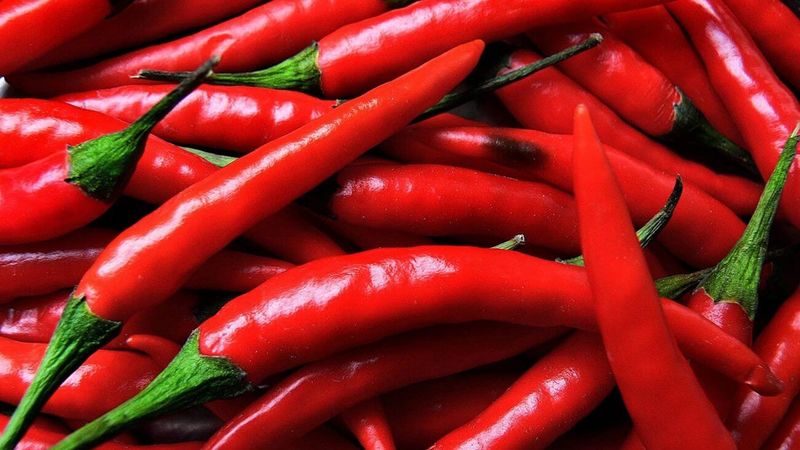
Having decided to prepare a healthy seasoning for the winter using the traditional method, first select the suitable fruits. Any type of hot pepper, both red and green, is suitable for drying. Even immature, pre-plucked fruits have sufficient pungency, since capsaicin is synthesized in peppers even before ripening. During the drying process, the taste of such fruits will change, more sweetness will be added, and their color will become similar to ripe peppers of the same variety.
The selection criterion is the absence of signs of spoilage on the fruits, such as: black spots, rotten parts, scab, and the like.
Before drying, the peppers are washed in running water to remove adhering soil and dust. If you plan to get a less spicy seasoning, remove the seeds before drying by cutting the fruit in half and removing the core.Seeds of hot peppers contain more capsaicin than pulp, so the plant protects future offspring from being eaten by animals. Those wishing to get a spicy seasoning are recommended to dry the peppers whole, if they are stored in powder form, they are also crushed together with the seeds.
Freeze
In contrast to drying, in which the pungent pods are often processed whole, when frozen, the fruit is usually crushed. They are cut to size and shape suitable for cooking.
Some housewives, when freezing hot peppers, remove seeds from the fruits.
 But there are those who prefer to preserve the sources of the burning taste and freeze the vegetable, cutting it along with the seeds.
But there are those who prefer to preserve the sources of the burning taste and freeze the vegetable, cutting it along with the seeds.
The sliced fruits are placed on a pallet in a loose layer, avoiding touching the slices. After a few hours, when the vegetable is frozen, the slices are transferred to a plastic bag or containers and stored in the freezer. Shake the bag (s) before freezing to separate the pieces from each other.
At a storage temperature of minus 18-22 ° C (optimal mode), a vegetable can be stored for up to six months without problems.
Uses frozen product in the preparation of soups (borscht, kharcho), stews, goulash, stewing and for making savory sauces.
Useful properties of hot pepper
Capsicum is composed of many chemical compounds that protect the body from disease and promote health. The burning taste of the fruit is given by the substance capsaicin.
- Capsicum has many beneficial properties:
- contains few calories, but at the same time remains an excellent source of vitamins A and C, potassium, folic acid and fiber;
- burns fat, since the capsaicin contained in it effectively increases metabolism;
- has antibacterial and analgesic effects;
- protects the body from the accumulation of cholesterol in the blood;
- reduces the risk of arthritis and other joint diseases;
- reduces the risk of developing breast cancer by 17%;
- reduces the risk of strokes and heart attacks.
Important! If, after taking spicy food, there is a strong burning sensation, acidic foods such as lemon or kefir will help reduce it.
- As for the contraindications for use, you need to take into account that:
- an excessive amount of hot pepper can burn the mucous membranes of the digestive system;
- a burning product can increase the risk of recurrence of diseases of the digestive system, liver, kidneys.
Side effects of consuming this spice in large quantities are heartburn, increased sweating, and stomach discomfort.
The subtleties of the collection
The first step to long-term storage of bell peppers or bitter capsicums is choosing the right variety. What the ripe fruit of a particular variety looks like is usually seen on the seed bag. Photos of the variety found in Google or Yandex also help.
IN PHOTOS: Many varieties are easy to find in photos in search engines, for example, Google Images.
The most ripe fruits are harvested first. After 4–5 days, the rest “reach”, and the collection procedure is repeated. The peppers are removed along with the stalk. In this case, you need to try not to damage the fragile stem, on which there are still fruits.
The last time the pepper is harvested is before freezing. All more or less large peppers are removed, and then they are divided into two groups:
- fully matured, at the stage of biological maturity;
- partially / not fully matured, reached technical maturity.
Storage conditions differ depending on the group.
IN THE PHOTO: Peppers that are not fully ripe, as a rule, have an uneven color. It's okay, within a couple of weeks they will reach the desired condition.
Recipes for the oven, airfryer and fresh air
There are several ways to dry red hot peppers. The longest time, but the most environmentally friendly option is the natural conditions of the environment, that is, in the fresh air.The quickest method to dry hot chili pods is in the oven.
 How to dry naturally
How to dry naturally
With this option, you will have to dry from 7 to 14 days
It is important that it is dry and preferably sunny outside - so the chili pepper will be enriched with taste. Otherwise, drying will not only be delayed, but the workpiece may become moldy.
You will need a convenient place, which can be a canopy, veranda, loggia or attic.
- If you plan to dry chili peppers whole, then a method with vertical hanging of the pods on a rope or fishing line in the form of a garland is suitable.
- If dried horizontally, use clean surfaces covered with cloth or paper.
Chili is laid out so that they do not find on top of each other and every day they are turned over. If the weather outside has turned bad, it is best to dry the chili using a fan or heat gun.
Dry with an oven
Preheat the oven to 50 degrees. Chili peppers are spread on a baking sheet, previously covered with wax or parchment paper. The oven door needs to be slightly opened - this way the air circulates better and the workpiece will not burn. Turn the fruit every 1.5 to 2 hours to dry evenly. The chili is dried by this method for 5 to 10 hours.
Dry in an airfryer.
It takes 10-12 hours to dry hot chili peppers in the airfryer. Spread the slices or pods in a single layer on the plates of the dryer and turn on the appliance at full power. Turn food occasionally to dry evenly.
The finished seasoning is checked as follows. It should break or crumble, be wrinkled, have a darker, more saturated color.
Hot pepper is stored in the form in which it was dried or you can grind it to powder. Store the seasoning at room temperature in a dry place in a glass jar or paper bag
It is important that there is no high humidity in the room where the seasoning is stored.
Read on:
How to dry bell peppers at home?
Shelf life of fresh bell pepper
The most popular freeze for the winter is bell peppers. All options and recipes.
Drying onions at home
4 ways to make raisins at home
Dried mint - when to harvest and how to dry properly
Previous
Vegetables The most popular freezing for the winter is bell peppers. All options and recipes.
Next
How to dry bell peppers at home?
How to prepare hot peppers for harvesting for the winter
You need to collect hot peppers when it is fully ripe and turns red. It is not recommended to pluck it green, as it will be worse stored, it will have less vitamin C and carotene than red. Also, ripe fruits contain many substances that are preservatives.

In order for the pods to be well stored, you need to leave only the best specimens and select all spoiled ones. To do this, you need to decompose the pods in a cool room in one layer and leave them to lie for about a week. Then all the fruits must be revised and the damaged ones must be selected.
It should be noted that this spicy vegetable does not require any special preparation for storage. To keep it until next season, you just need to wash the pods and remove moisture from them. But sometimes it is necessary to cleanse the product from seeds, because with some types of storage it can become more bitter - it is the seeds that will cause this pungency.
Important! It is better to store fresh fruits in a dark room and sort them constantly. Fresh, they can lie no more than 2 months .. Before starting harvesting, the peppers must be thoroughly washed and cleaned of earth residues, insects and other dirt
It is best to rinse the fruits by placing them in a bowl with slightly warmed water for a couple of minutes. During this time, the dirt will come off the vegetables, after which they must be washed again in cold water and dried with a towel.
Before starting harvesting, the peppers must be thoroughly washed and cleaned of earth residues, insects and other dirt. It is best to rinse the fruits by placing them in a bowl with slightly warmed water for a couple of minutes. During this time, the dirt will come off the vegetables, after which they must be washed again in cold water and dried with a towel.
In addition to simple cleaning of the fruit, you must also follow the recipe. If you want to cut vegetables in half, then you must definitely remove the core from them and peel them of seeds. Only then can you proceed to further canning.
How to choose peppers for storage
Hot peppers can be kept fresh in a cool place for up to several months. To preserve this vegetable at home for a longer period, use the following storage methods:
Regardless of which option for preserving the beneficial properties of the product is chosen, the fruits for storage are selected in the same way. They must be ripe and free from external defects (dents, cracks, rot).
It is preferable to take a variety of vegetables for harvesting of a medium or late ripening period. Thick-walled peppers are more suitable for freezing and canning, while thin-walled peppers are more suitable for drying.
For example, the fruits of the Burning Bouquet, Dragon's Tongue, Indian Elephant, Astrakhansky 147, Chile varieties are recommended for drying, and the Miracle of the Moscow Region, Ogonyok, Vizier and Double Abundance varieties are recommended for freezing and canning.
Pepper preparation
Before storing hot peppers for the winter, prepare the harvest. First of all, the degree of maturity of the chili is chosen. The ripeness of hot peppers is technical (the fruits have reached the required size, but have not acquired the characteristic color of the variety) and biological (the fruits have acquired the size and color corresponding to the variety).
Bitter pods are most often harvested for the winter at the stage of their biological maturity. At this stage, they accumulate the maximum amount of nutrients and increase keeping quality, thanks to the maximum dose of capsaicin, a natural preservative. Green fruits are worse stored, have a less pronounced taste and smell, but they are not as pungent.
If it is possible to harvest the crop on your own, the pods are cut with scissors together with the stalks, without squeezing with your hands. After collecting, they are kept in the open air for at least 7 days, for which they are laid out in boxes or on trays.
For long-term storage, healthy specimens are selected with a smooth skin, without cracks, dents, traces of deterioration and other damage. An exception is freezing - for it, you can choose fruits with small defects, but not spoiled.
To avoid burns on the skin, you need to work with pepper in disposable gloves and do not touch other parts of the body with your hands. If burns cannot be avoided, the skin is thoroughly washed with cold water and soap and smeared with cream.
The selected fruits must be thoroughly washed and dried naturally, spreading on napkins or towels. There is one secret of how to store hot peppers in the pods: you can remove the seeds and inner partitions - the bitter part of the fruit. If this is not done, the pulp will become even more pungent.
Drying methods
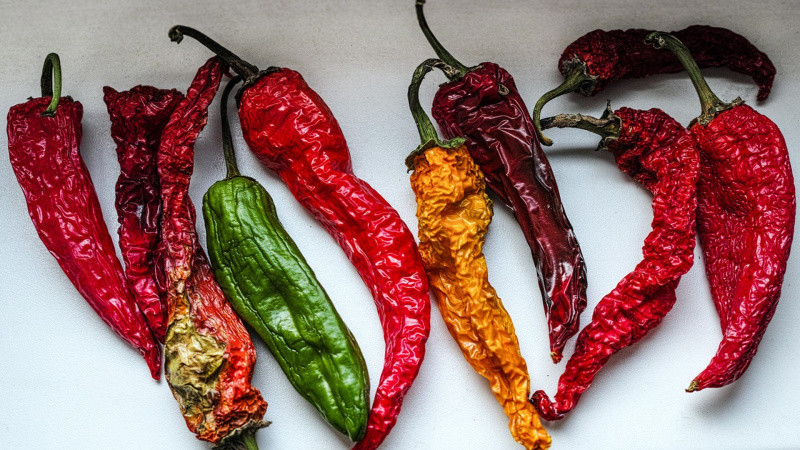
Depending on your inventory, choose one of the drying methods:
- in the air: a simple process, does not require equipment, can be dried both in the sun and indoors;
- in the oven: it will take several hours in time, but you will have to control the progress of the process so that the peppers do not burn and dry evenly;
- in an electric dryer: a short automated method - if this useful unit lives on your farm, feel free to use it.
Air drying
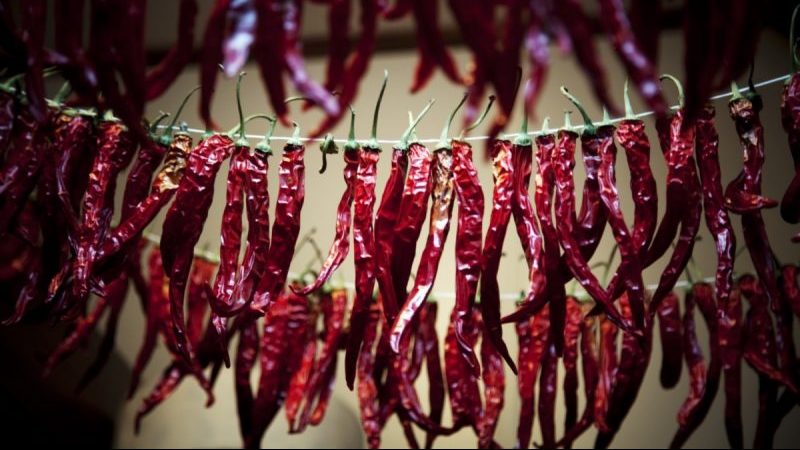
Proven for centuries, this method is economical and simple, it can be called drying "for the lazy". The natural process lasts from one to two weeks, depending on the humidity of the air. If you have there is a free attic or other space with an abundance of unoccupied surfaces, you can use a horizontal dryer. When there is not enough space, the peppers are hung and dried in the form of "garlands".
When drying, pay attention to the humidity in the air. Peppers can grow moldy or rot in high humidity.
Dry, sunny weather is the best condition for getting a hot seasoning quickly.
Horizontal drying
After preparing the fruits (washing, removing seeds), the peppers are evenly laid out on paper. A moisture-absorbing newspaper or blotting paper will do; no one forbids using paper napkins either. Make sure that the peppers lie at some distance from each other and do not touch.
The thicker the layer, the slower the moisture evaporates from the surface, so whole peppers can be pressed down a little to give them a slightly flattened shape.
To dry evenly, turn the peppers every day, and change the paper bed every two to three days. Unripe fruits at the same time acquire an even appetizing color, and the drying time is shortened.
If drying takes place in the open air, in the evening the peppers are covered with gauze or any other cloth so that dew does not fall on them and insects do not attack.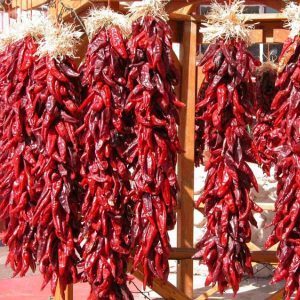
Drying in the form of "garlands"
A needle, pointed match, or toothpick is attached to a strong thread, line, or rope. The washed fruits are strung by the tail so that they do not come into contact with each other. "Garland" is ready, it remains to hang it in a ventilated darkened room and wait for the result.
Drying in the oven
For the most impatient, the oven-drying method is suitable. You can use either an electric or a gas oven, as long as you can adjust the temperature.
Place parchment paper on a baking sheet. The washed and prepared peppers are laid out on paper so that they do not come into contact with each other. The baking sheet is placed in an oven preheated to 50-60 ° C. The oven door does not need to be closed tightly to ensure a constant flow of air. During drying, the peppers will have to be turned over so that they dry equally from all sides. By observing these conditions, you will get exactly dry seasoning, and not baked or burnt fruits.
This drying can take from 5 to 10 hours, depending on the size of the fruit, the flow of air and the design of the oven. During this time, once every one and a half to two hours, you will have to do control checks for the readiness of the seasoning (test the pods for fragility) and make sure that the peppers do not begin to dry out or burn.
Drying in an electric dryer
If you have such a useful unit as an electric dryer at home, it will not take much time and labor to prepare the seasoning. The washed fruits are placed on the wire rack, in the same way as peppers are laid out on a baking sheet when drying in the oven.
To prevent the harvested peppers from sticking to the grate, they are periodically turned over during drying or placed on clean gauze. Drying time at full power of the electric dryer will be 10-12 hours.

